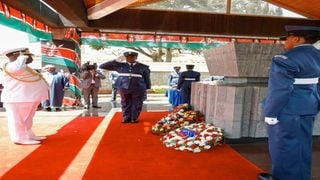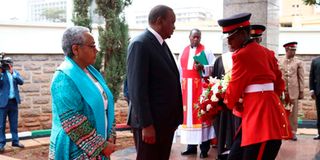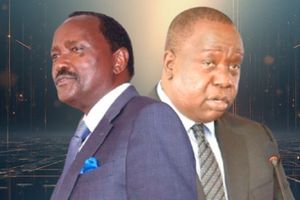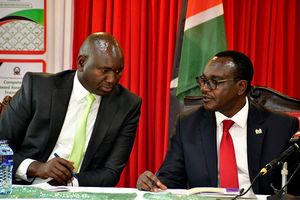
Mzee Jomo Kenyatta’s grave at Parliament Buildings in 1988.
| File | Nation Media GroupNews
Premium
Why it is time to open Jomo’s grave to the public or shift it to Gatundu home
What you need to know:
- A public maintained mausoleum has remained private and is only accessed by dignitaries.
- The man who laid the foundation of the country has been left caged, guarded – and a presidential legacy is going to waste.
Today is the 43rd anniversary of the death of the founding President Mzee Jomo Kenyatta. And for the second year running, there will be no commemoration of his death which, for years, was marked with the ceremonial laying of the wreath at his mausoleum on Parliament grounds in Nairobi.
For scholars of monuments, and historians alike, this is a sign of the continuing political struggles on the place of Jomo Kenyatta in the national politics. Such struggles are not new in African politics – and they are going to dominate our space whether the functions are held in private, or in public.
But why have we let Kenyatta’s grave to be a contested symbol of our pride?
In 1978, shortly after Kenyatta’s death, some Western newspapers quoted members of Kenyatta’s inner-circle saying that Jomo would be buried in a glass sarcophagus, just like Vietnam’s founder Ho Chi Minh – “Uncle Ho” – and whose body is preserved in a large Russian-designed mausoleum in the capital, Hanoi.
The papers reported that the Kenyan politicians wanted to mimic other countries which embalmed their founding leaders with the help of scientists at the Soviet Union’s Lenin Lab who had perfected the art of embalmment. It is these scientists who, up to now, maintained on display the body of Vladimir Lenin in Moscow since his death in 1924.

President Uhuru Kenyatta (right) and First lady Margaret Kenyatta at the late Mzee Jomo Kenyatta mausoleum during the 41st commemoration service of Kenya's first president death on August 22, 2019.
They were also behind the preservation of Bulgaria’s Georgi Dimitrov between 1950, when the leader died, and 1990, when the remains were cremated after the fall of communism. Before that, and like in Kenyatta’s case, the mausoleum was guarded by the elite paramilitary troops and was part of State ceremonies where foreign dignitaries were taken to lay wreaths. So contested was this mausoleum that nine years after the body was cremated, it was demolished by the government of Ivan Ivan Kostov in 1999.
And that is what happens when these spaces become contested.
Having said that, there is something wrong with how we have treated the good old Jomo. First, for 43 years, Jomo’s grave has been a no-go zone for ordinary Kenyans. Why – nobody explains. Second a public maintained mausoleum has remained private and is accessed open to dignitaries. And finally, the man who laid the foundation of the country has been left caged, guarded – and a presidential legacy is going to waste.
It is true that monuments, for eons, have become contested spaces but I am yet to see a country that has little regard to its founding presidents. As we have seen, in many countries, monuments have been destroyed, or left to rot, renovated or modified to reflect some contemporary agendas.
Some three years ago, when President Uhuru Kenyatta announced the formation of Presidential Museums and Libraries, it was hoped that, by now, such public libraries would be up and running and that part of its mission was to have Mzee’s grave open to the public besides setting up of a proper presidential museum.

President of the United Republic of Tanzania Samia Suluhu Hassan at Mzee Jomo Kenyatta mausoleum on May 4, 2021.
We should learn from a few African nations and let me give some parallels – in the hope that somebody will show this to President Kenyatta.
Those who have been to Butiama, Julius Nyerere’s birth place, have seen how the simple mausoleum and homestead is a centre of attraction since it is open to the public. Here, Tanzanians are able to pay homage to their founding father of their nation. The entry to the mausoleum is usually free and open to everyone.
At his adjacent Butiama homestead, there a curator who takes guests around the place Nyerere used to call home and are shown his mementoes, photos and other instruments of power. Visitors pay a token to help maintain the place.
Each day, and like in a museum, hundreds of students and tourists eager to learn Nyerere’s history visit Butiama to appreciate the man they knew as Mwalimu. Nyerere was Jomo’s contemporary.
In Uganda, the Kasubi royal tombs, housing the mausoleums of four former Buganda kings, and before they caught fire, would attract thousands of tourists. The burning of Kasubi tombs, perhaps by arsonists, was an indicator of the importance of guarding such contested spaces. Kasubi is the resting place for Kabaka Muteesa, who died in 1884, Kabaka Mwanga II, Kabaka Daudi Chwa II and Kabaka Mutesa II and is today recognised as a Unesco World Heritage Site since 2001. If Buganda could preserve the tombs of their leaders since 1884, why are we ignoring our national history?

Former UK Prime Minister Theresa May and other dignitaries at Mzee Jomo Kenyatta's mausoleum on August 30, 2018.
It is the same story in Malawi where in 2006, Malawi’s President Bingu wa Mutharika, opened the Kamuzu Banda mausoleum which is located in Lilongwe – adjacent to the country’s Parliament. Here, they have posted an official from their Ministry of Tourism to explain Banda’s place in Malawi’s history and the splendid structure is open to the public.
It is a pity that Banda’s grave has no library, or museum, attached to it which makes it unattractive to scholars and students. It is again a pity that Dr Banda’s archives as collected by his biographer Dr Donald A. Brody and which includes published and unpublished correspondence, speeches, manuscripts, diaries, photographs, and fabrics are today housed at the University of Indiana Bloomington – far away from the people he led all those years.
This is the same case with another of Jomo’s contemporary, Kwame Nkrumah, who was deposed in 1966. A pan-Africanist per excellence, Nkrumah spent six years in exile and when he died in a Budapest clinic in Romania, his body was taken to his Nkroful village from Conakry – where he lived in exile – and buried on July 11, 1972 after negotiations with the military leader Colonel Ignatius Acheampong. It took 20 years before President Jerry Rawlings’ issued an edict to have the body exhumed in 1992 and transferred to the former British colonial polo grounds in Accra, where it was interred with full military honours.
Nkrumah had a huge archive but this has yet to reach Ghana. His Literary Executrix was the late Mrs June Milne who had left part of it at the Howard University in the US. Before she died, she was looking for space in Ghana to house the material. It is reported that she left some material at her London home and these have since been moved to the University of South Africa (Unisa).

Former First Lady Mama Ngina Kenyatta lays a wreath at the late Mzee Jomo Kenyatta mausoleum during the 36th memorial at Parliament Buildings on August 22, 2014.
The last case I will use concern Nelson Mandela, whose grave is located at the family farm in Qnu. But the Nelson Mandela Foundation remains the best organisation that has succeeded in keeping a leader’s legacy alive.
The foundation has in its custody a huge archive of the life and times, works and writings of President Mandela – and attracts thousands of visitors and scholars. They have also digitised most of the letters and documents. So, there is a chance to see the handwritten papers, official records and unique artefacts.
After 43 years since the death of Kenyatta, we have to ask: where are the Kenyatta archives (and do not direct us to Kenya National Archives!)? Where are his papers, books, letters and notes. I have seen some of these catalogued in some foreign archives and universities.
Lastly, if Jomo’s grave cannot be opened to the public, it is time the body is shifted to Gatundu home – where the family will have a duty to protect the tomb. But if we are to open an archive facility adjacent to it – the better. It will be a living mausoleum – and we can learn from the others.
[email protected] @johnkamau1





